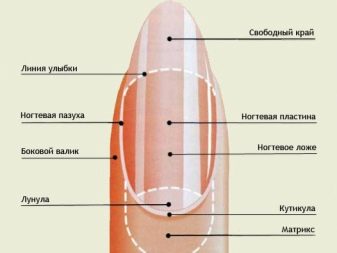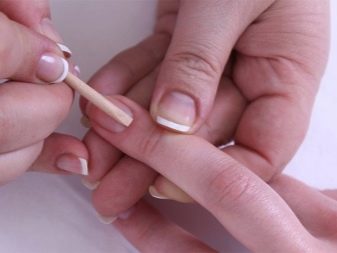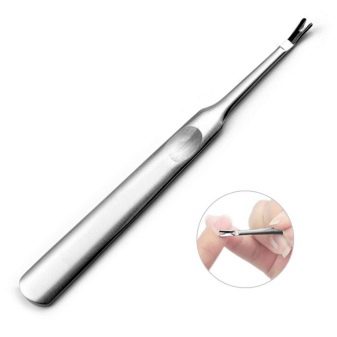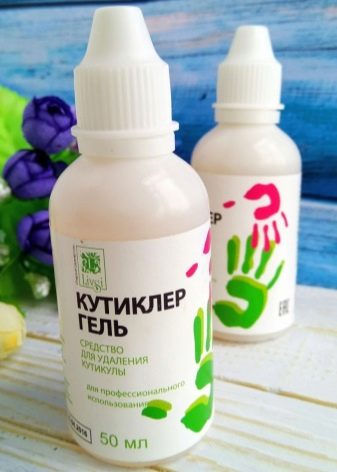Nails of even the most beautiful form will look groomed without proper care of the cuticle. This modest skin roller performs an important function and, of course, requires attention, including aesthetics.


What it is?
The cuticle on the nails is a leathery seal at the bottom of the nail plate, also called a leathery roller. Partially, it disappears under the skin, so only its dried edge is visible to the eye. In the medical vocabulary it is called pterygium, and the rest of the cuticle is eponychium. The cuticle as a whole is responsible for protection. Without a leathery roller, bacteria would easily penetrate under the nail, disrupting its natural development. The cuticle protects both the nail bed and its matrix, that is, the root part, from moisture and air. If the root were damaged, then the nail itself began to break, exfoliate and develop worse.
Incidentally, the continuation of the matrix — the lunula — does not protect the cuticle, therefore, there should be additional care for it.


Tools and supplies for care
To remove the cuticle, the easiest way is to use an orange stick. This wooden structure has a length ranging from 9 to 18 centimeters and a width of 3 to 5 millimeters. One tip is at an angle, and the other is well pointed. In one package there are several pieces of sticks, which makes the purchase convenient and economical.According to the rules, an orange stick is a one-time product that must be changed after each manicure.
A wooden pusher is stored in a dry and clean space. By the way, its additional advantage is the ability to use for cleaning dirt from under the nail plate. Recently, a European alternative is considered a worthy alternative to an orange stick. This tool is a soft file that does not injure the nail, which also has a polishing function. Depending on the color of the device, you can determine how strong the impact will be. Gray pumice is the most tender, pink is a little stronger, and yellow is as hard as possible.


In the salon, a special machine is most often used to eliminate the cuticle, whose nozzle neatly, without injuring, cleans each nail. The device works from the mains. It takes no more than one minute to process each finger. There is still such a not-so-popular tool, like a cuticle removal knife. It looks like a double-toothed fork, which is extremely inconvenient to use without preparation, so its use is best left to professionals.


How to prepare a cuticle for removal?
The easiest way to prepare the cuticle for further processing, after holding your fingers in the bath for hands. In a convenient container, warm water is simply poured into which you can pour sea salt (but this is optional). The procedure lasts from 15 to 20 minutes, after which the fingers need to be thoroughly dried with a towel and immediately begin the removal process.

Removal Methods
There are several ways to handle cuticles. At home, experts recommend doing without circumcision, but simply pushing away the excess leathery part with an orange stick. In the salon of a trusted master, you can try a more intense effect.
In general, the method of eliminating the cuticle can be selected depending on one's own desires and the state of pterygium.


Edged
The meaning of the cut manicure is that the excess skin is simply cut off. Doing it yourself is not recommended, so it is better to contact a professional in the salon. If a person is sick with diabetes, then this type of treatment is strictly prohibited. Cutting of the cuticle is carried out using standard tools: manicure scissors and tweezers. Pre cuticle necessarily softens.
With a pusher or orange stick, the excess skin moves to the base of the nail, after which they are cut, moving from the sides to the central part of the nail. Everything needs to be done carefully, without tension, just cutting off the already dead process. The procedure ends with disinfection of the wounds with hydrogen peroxide and nourishing the skin with a fat cream.


Cut manicure is considered the least successful, because after trimming the new cuticle grows denser and it has to be processed more often.
In addition, such a procedure is not absolutely safe - any inaccurate movement leads to wounds. In some cases, there is even a chance of infection of the matrix. Deciding to have a manicure trimmed, it is important to steam the cuticle well, and treat it with an antiseptic and a special restorative ointment at the end of the procedure.

Unedged
Taking a sufficient amount of time, unedged manicure is carried out using a special stick and a cuticle remover, called a remover. The pusher stick can be made of plastic, silicone, or it can be disposable from an orange tree. A remover, as a rule, incorporates various acids, from dairy to fruit, with the help of which the already dead cells are split. The procedure begins with the basic preparatory stage, after which three nails are covered with a remover.You should start only with three fingers, so that it does not turn out that the product has been on the epithelium for too long.
According to the instructions, the duration of the remover is counted, after which the excess is carefully removed using a cosmetic disk. Pusher cuticle moves to the very base of the nail, and dried pieces are removed with cotton.
It is important to mention that the work of the orange stick begins only when the remover is dry, which means it will finish acting. The procedure ends with the use of oil, which will slow down the growth rate of the cuticle.


A variety of unedged manicure can be called a hardware procedure, which is carried out using a special machine. Working like a grinding file, this device gently eliminates the dead cuticle, without affecting the living and healthy. This procedure is recommended only in the cabin.

Push back
In the case when a person’s cuticle grows very slowly and looks invisible, you can’t do anything special with it - just push it to the base. In this case, having prepared the nails, it is necessary to apply ordinary oil or gel on them, after which move the pterygium and generously spread the cream with hands.


Subtleties of processing
Before you do cuticle, you need to perform a few simple steps. First, the nail plate must be exempted from varnish or shellac. This is done with a nail polish remover or wipes designed for this purpose. Following one of the above methods, excess cuticle is removed. In the final, the nail necessarily receives food - it is smeared with oil, cream or wax.
Cream can completely cover the hands, increasing the impact in the cuticle area. Specialists also recommend peeling the pens from time to time or scrubbing them with a substance that acts on the nail plates.
Timely treatment will prevent the growth of the cuticle and cope with excessive peeling. For this purpose, it is better to take a peeling roll or a regular remedy, which contains fruit acids and vitamins.


Funds
There are a large number of products designed to care for cuticles. All of them pursue the same goal, but produce a different effect. The oil can be a special cosmetic or regular pharmacy. Experts recommend paying attention to the presence in the composition of avocados, jojoba and a derived product of grape seed, which deeply penetrate the cuticle, moisturizing and nourishing it. In the case when, in addition to caring for pterygium, the aim is to strengthen the nails themselves, it is worth buying citrus oils, for example, lemon.
Almond, castor, shea and coconut oils, as well as a mixture of vitamins A and E, can enhance the development of cuticles. Wax is used for polishing and sealing. It is also used to cure burrs, to give pterygium elasticity and to make nail plates themselves more presentable. Most often, wax is combined with a special file.


For protection against varnish
Currently, the market has enough funds to avoid staining the cuticle during manicure. For example, it makes sense to purchase a special protective elixir that looks the same as regular varnish, but is applied not to the nail plate itself, but to the cuticle. Sometimes it is also called liquid tape. This coating dries with a silicone film, which is simply removed at the end of the manicure, performing the required function.
No negative effects on the nails during this procedure occurs. In addition, a special pencil is sold in the store that removes excess varnish from the cuticle in case it wasn’t possible to stain it.


To slow growth
There are also drugs that can either slow down or stop the growth of the cuticle. These include nail oils, as well as dual-action removers.For example, Avon's cuticle care product has a similar effect.

Cuticle remover
To split the skin roller to such a state that it will be enough to remove it with a cotton pad or orange stick, you can use a remover, which is a special tool - keratolytic, which does not somehow affect the living part of pterygium, but destroys the already dead. The composition of such a remover includes either fruit acids, or a combination of ammonia and carbon dioxide. In addition to softening, this product is responsible for moisturizing and healing., but after the procedure it is still recommended to use additional solutions. Keratolytic can be sold in the form of a liquid, oil, balm or gel. The products of the OPI and Librederm Corrector brands are popular in this segment. Kutkler from KVplus has also established itself.


Folk methods
Carrying out the procedure for caring for the cuticle at home, you can use the means at hand (that is, folk). For example, to soften not too rough skin, instead of a professional remover, it will be enough to use a warm bath with salts and various essential oils. In addition, disinfecting the nail space is allowed with chlorhexidine or peroxide, which are sure to be found in a home medicine cabinet.
If we are talking about protecting the cuticle from varnish, then from folk remedies, the use of oily cream, petroleum jelly or even PVA glue deserves attention. When applying one of these products only to the skin roller, a texture is created that the varnish cannot be painted over.
To remove the remaining product will either cotton pad, or just with your fingers in cases where it is enough to pull the film.


Possible problems
Some girls are faced with such an unpleasant situation when the cuticle is frowning, that is, it is covered with burrs. The reasons for this are most often the following:
- lack of vitamins in the human body;
- low consumption of clean water;
- insufficient external care.
In this case, the cuticle becomes dry and grows quickly. In addition, burrs may be the result of improperly trimmed manicure. The injured pterygium is trying to regenerate and therefore is rapidly growing. The skin is also tinted due to the fact that the skin of the hands of a person is initially dry, and the cuticle is too dense and roughened.


All cases can be corrected by changing both the care system and nutrition. Sometimes, you may even have to change your lifestyle. It happens that the cuticle hurts due to inflammation. There are many prerequisites for this situation: it can be improper care, and microtrauma, and various diseases, and the use of too concentrated chemicals in everyday life or low-quality varnishes. In this case, most likely, specialist treatment is required.
When the cuticle itches after a manicure, this may signal an allergic reaction to the material used. In such a situation, it is again recommended to consult a doctor in order to avoid more serious consequences. Another likely cause of itching is a fungus. To solve the problem, you should purchase special antifungal agents at the pharmacy, but consult with your doctor first. Finally, often pterygium even grows to the nail due to improper care. In this case, you will need to introduce regular oil treatment to prevent such troubles.


The resulting abscess will be able to be cured on its own, if several salt baths are taken, timely treatment of the damage with peroxide, and also use ichthyol ointment. Bleeding that occurs during a manicure is stopped with a cotton swab soaked in hydrogen peroxide. A large wound will need to be treated with medical glue.


See how to remove a cuticle in the next video.










